|
Quick tips for National Potato Month, September, on how to buy and store potatoes (National Potato Day is August 19th).
HOW TO BUY POTATOES
FIRM. Choose potatoes that are firm, with smooth skin. Avoid potatoes that are too soft, greenish in color or have cuts, sprouts or blemishes. These are more likely to be bitter, and green-tinged potatoes and those that are sprouting can even be toxic.
SIZE. Choose potatoes that are uniform in size, so that they will take the same amount of time to cook when you prepare them.
RECIPES. Potatoes are cheaper when you buy more of them. If you think a large bag will be more than you can use, expand your potato repertoire: not just as a side dish but in potato soup, vegetarian curries and stews, potato pancakes and potato torta for brunch, and the always-popular potato salad. Treat yourself to a potato cookbook for ideas beyond baked, fried, mashed, etc.
HOW TO STORE POTATOES
Potatoes don’t go bad quickly, and can be stored for up to 6 months.
PLASTIC. Don’t store potatoes in airtight plastic bags. If they are sold in plastic, the bag should have cut-outs to enable breathing.
PAPER. If storing potatoes in paper bags, leave the bags open at the top to allow for easy breathing.
DARK. Store potatoes in a cool, dark and clean place or they will sprout more quickly.
MOISTURE. Avoid any extra moisture, but don’t store potatoes in a bone-dry place or they will start to lose their natural moisture and shrivel up.
NO FRIDGE. Don’t store raw potatoes in the refrigerator. When stored at temperatures below 40°F, the starch converts to sugar, and the moisture will cause sprouting.
NO LIGHT. Shield potatoes from light. When exposed to light, potatoes become green-tinged, which is a sign of chlorophyll and toxic alkaloids (see the next section).
NOT TOO COLD. When potatoes are stored too long in a too-cold environment (below 40°F), the starches convert to sugar. This not only makes for an overly-sweet potato but also alters the cooking chemistry, resulting in uneven cooking performance and discoloration.
SEPARATE. Don’t store potatoes near onions. Proximity to onions causes potatoes to sprout more quickly.
DON’T EAT POTATOES THAT HAVE TURNED GREEN
Potatoes that have developed green coloration may be harmful.
Potatoes exposed to excess light may turn a greenish hue on its skin, flesh or sprout. This is due to the development of solanine, a glycoalkaloid. It is a natural toxin present in potatoes, but extra light causes it to grow to dangerous proportions.
Solanine may upset the digestion and cause discomfort—or worse. Solanine that is consumed in high quantities can lead to paralysis [source].
Cooking a green potato does not make it safe. While you can can usually cut away the green portion and safely eat the remainder, the potato can bitter. It’s best to toss it.
COOKING POTATOES
SKINS ON. Potatoes are easier to prepare and healthier to eat when their skins are left on.
SOAK & SCRUB. Potatoes are typically washed before they are shipped to be sold, but should be washed again before food preparation. Soak potatoes in cool water to loosen the dirt; then scrub them gently with a vegetable brush or sponge. Trim away any eyes or blemishes.
DON’T FREEZE. Freezing cooked potatoes is usually not a good idea. Since potatoes are 80% water, they become watery and grainy when reheated. Manufacturers of prepared potatoes have methods to circumvent this, but a home freezer can’t.
POTATO NUTRITION
Potatoes contain many essential nutrients. The skin of the potato contains half of the fiber; more of the nutrients are found within the potato itself.
Because potatoes are high in carbohydrate, there is a misconception that they are fattening*. However, the calories come from the ingredients with which the potatoes are prepared—butter and cooking oil, sour cream and gravy.
ANTIOXIDANTS. Potatoes contain phytochemicals like carotenoids that help protect cells in your body from damage.
FIBER. A medium potato has 2 grams of fiber, representing 8% of your daily recommended amount.
IRON. With only 6% of the daily recommended amount of iron, potatoes aren’t known for their iron content. Still, it’s a contributing nutrient that keeps you healthy, and every little bit counts.
POTASSIUM. A medium potato with the skin provides 620 milligrams of potassium. In fact, it’s considered one of the most potassium-rich foods available as one serving of potatoes provides 18% of the daily recommended amount of potassium.
VITAMIN B6: A medium potato offers 10% of the daily recommended amount of vitamin B6.
VITAMIN C: You may think of orange juice when it comes to vitamin C, but it’s time to rethink. Potatoes have 45% of your daily recommended amount of Vitamin C.
> TYPES OF POTATOES
> POTATO HISTORY
SWEET POTATOES: DISTANTLY RELATED
There are many different shapes, sizes and colors of sweet potato: orange, purple, red and tan varieties can be found. However, none of them is related to the white potato, or to the African yam.
The sweet potato diverges from the sweet potato at the family level, Solanales
The taxonomy of the white potato: class Magnoliopsida, order Solanales, family Solanaceae, genus Solanum, species: S. tuberosum.
The taxonomy of the sweet potato differs at the family level: class Magnoliopsida, order Solanales, family Convolvulaceae, genus Ipomoea, species, I. batatas.
The yam has comes from a completely different class and order: class Liliopsida,
order Dioscoreales, family Dioscoreaceae, genus Dioscorea. There are some 600 species of yam.
National Sweet Potato Day is February; Sweet Potato Awareness Month is November.
|
|
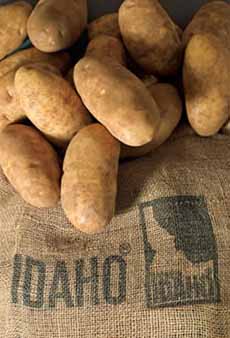
[1] Russet potatoes, the standard for baked potatoes and French fries.

[2] Tricolor baby potatoes. Baby potatoes are new potatoes—potatoes harvested when immature. They are not the same as creamer potatoes, which are smallest variety of potato and more flavorful (photo © Recipes Worth Repeating).
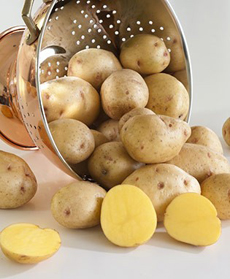
[3] Yukon Gold potatoes (photo © Bonnie Plants).
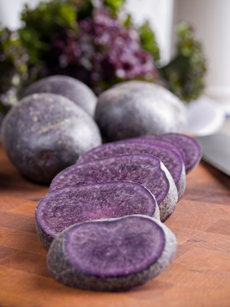
[4] Purple Peruvian potatoes (photo © Mona Makela | iStock Photo).
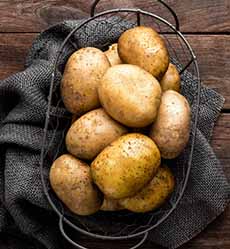
[5] All-purpose white potatoes (photo © Idaho Potato Commission).
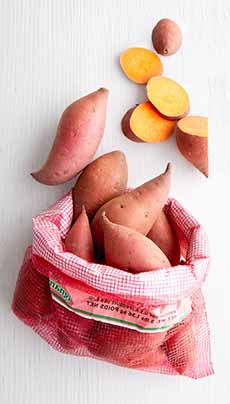
[6] Sweet potatoes are different from white potatoes, and completely unrelated from yams. See the explanation at the end of the article.
|








